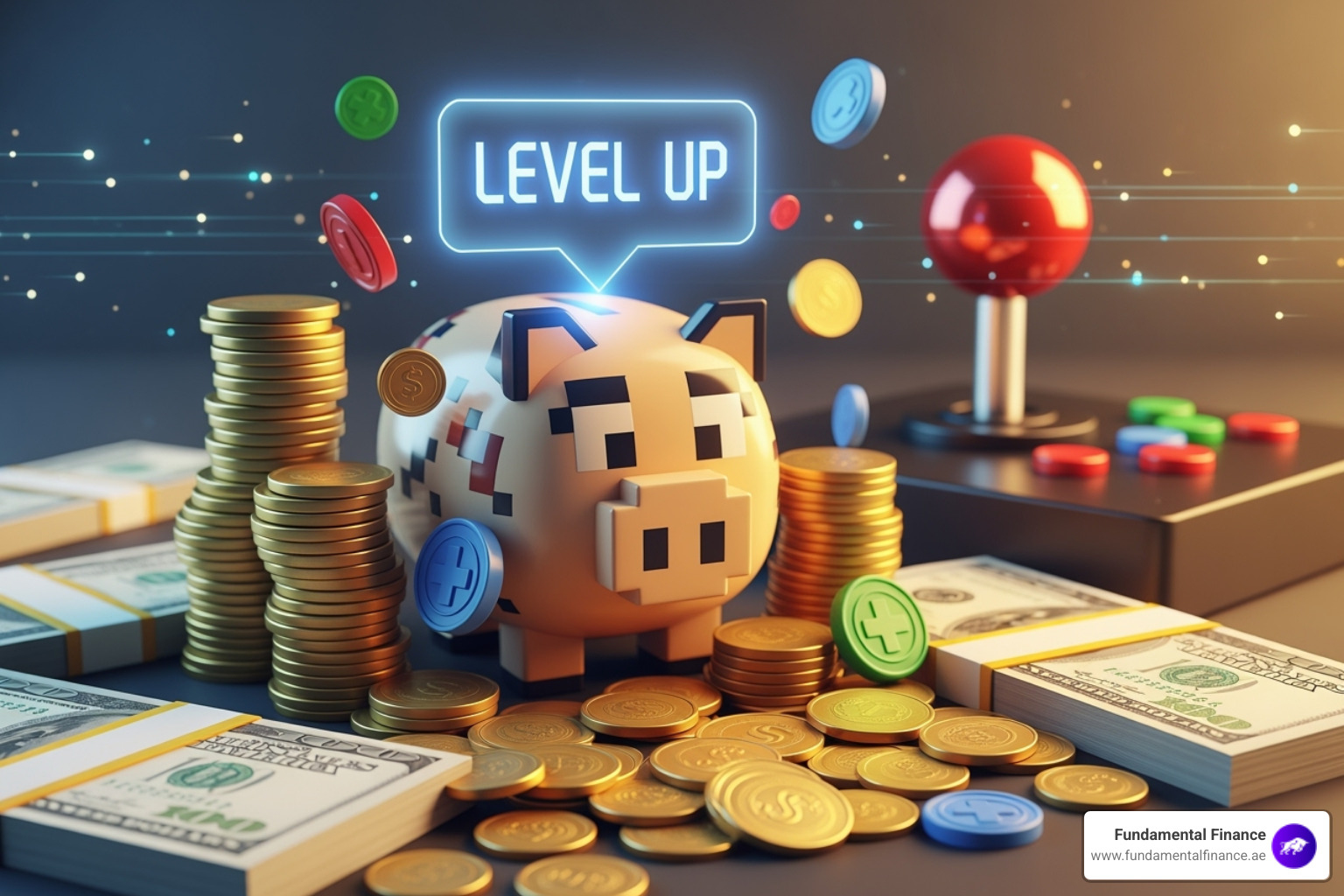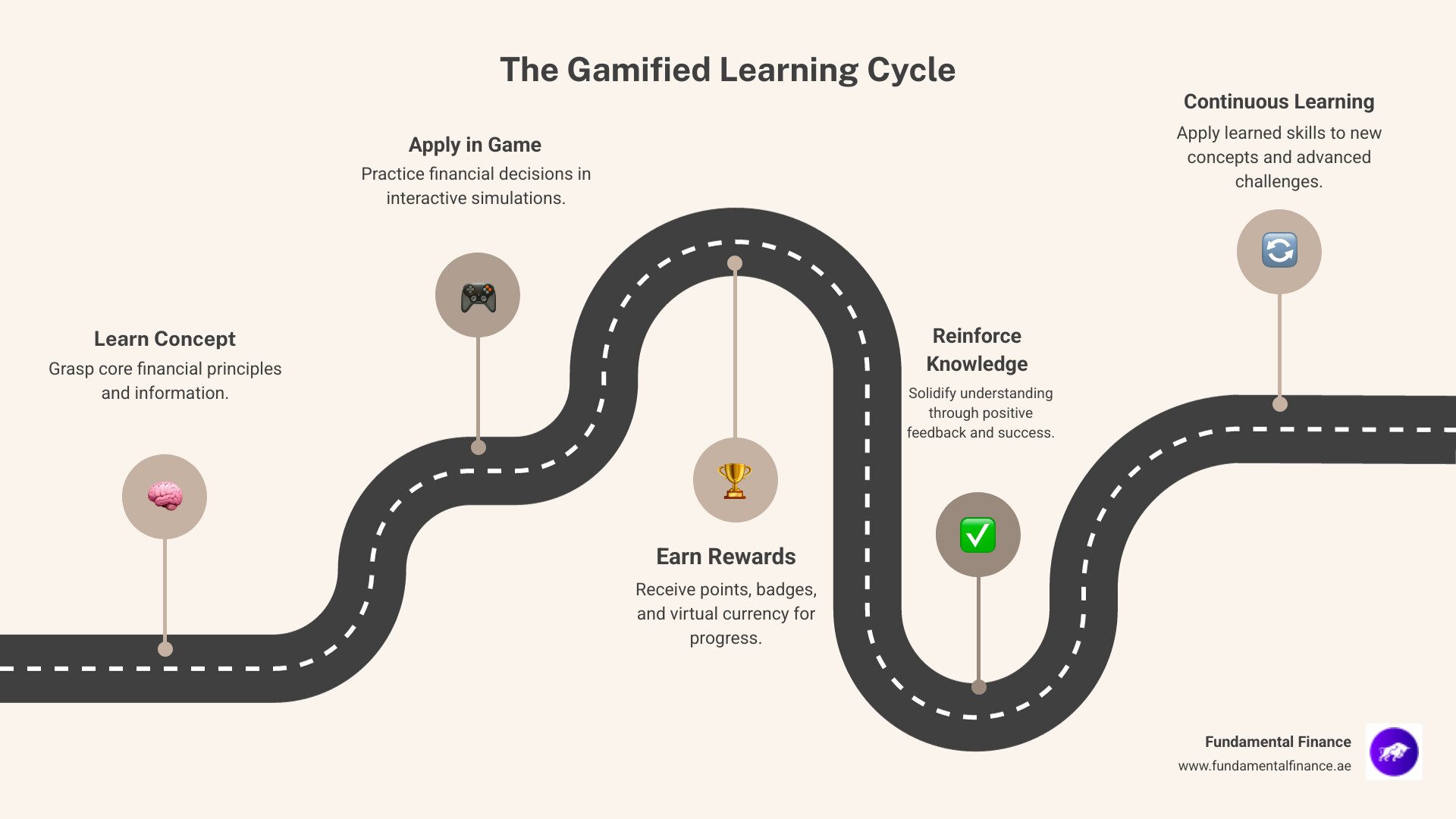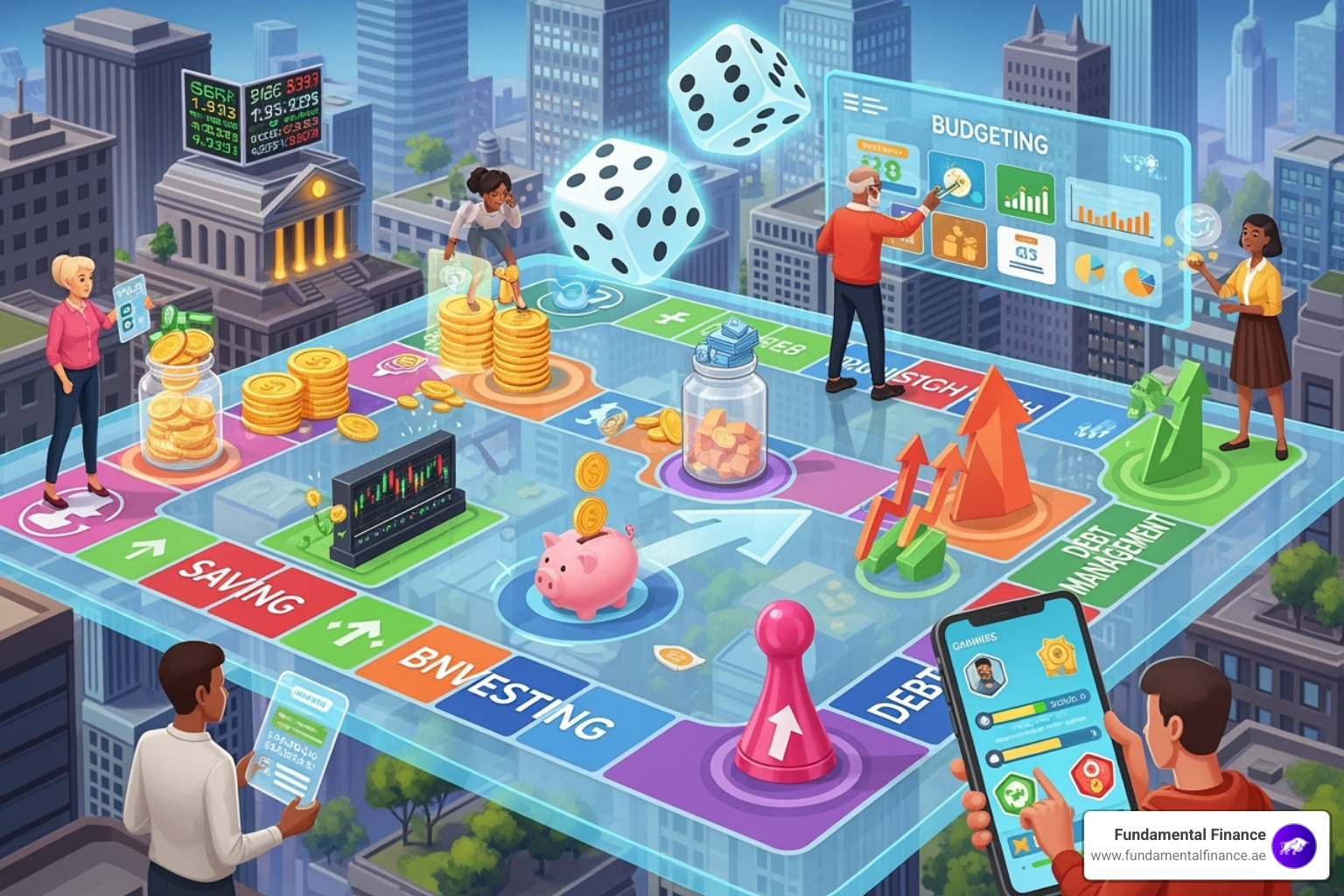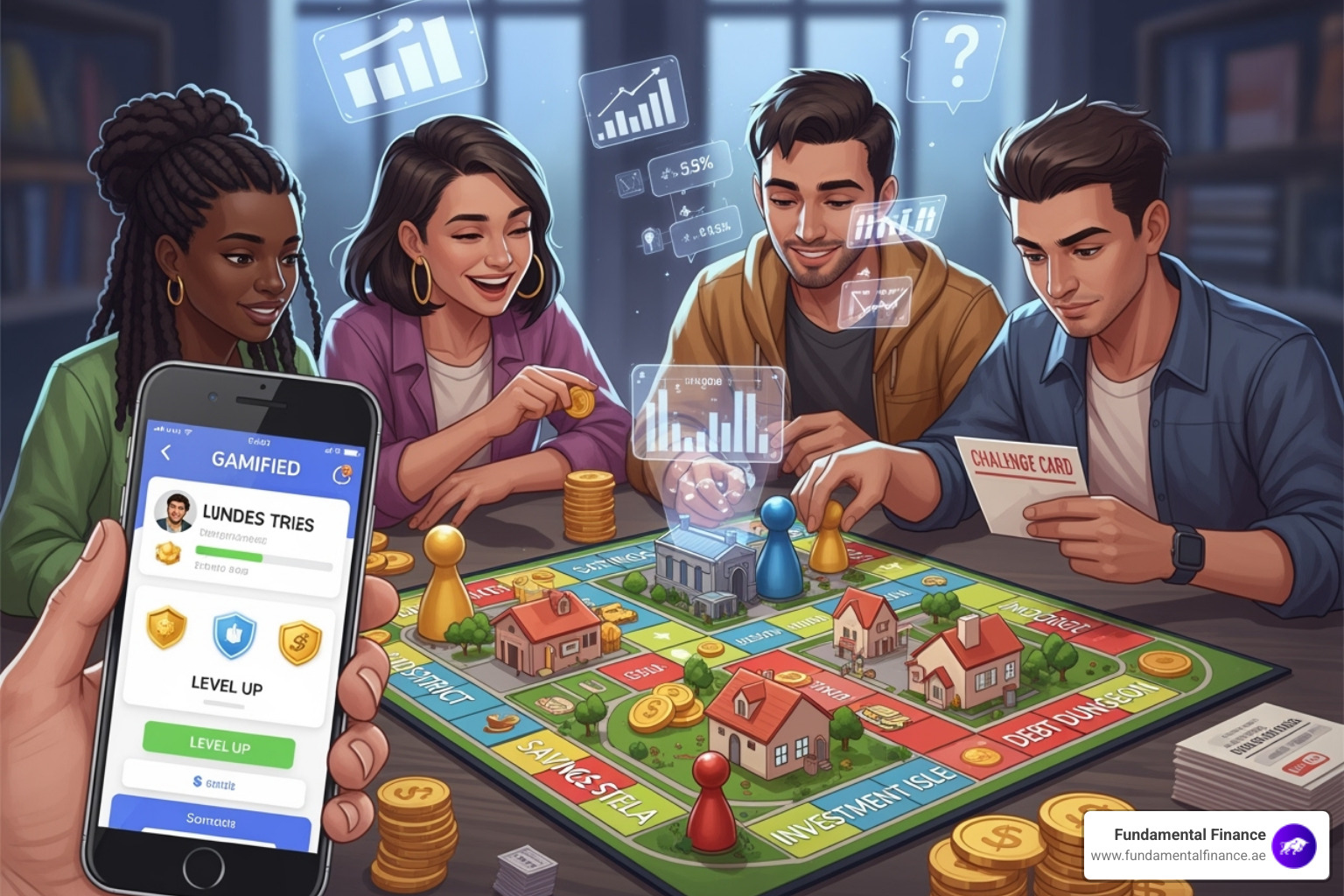All About Gamified Financial Literacy in 2025
Time to Read:
9-10 minutes

Why Gamified Financial Literacy is Changing How We Learn About Money
Gamified Financial Literacy makes learning about money engaging by combining financial education with game elements like:
- Points, badges, and rewards to motivate learning
- Real-world simulations to practice financial decisions safely
- Interactive challenges that build confidence gradually
- Personalized experiences that adapt to individual learning styles
This approach is crucial, as 73% of adults say money issues are their number one cause of stress. Furthermore, the average financial literacy level for young adults aged 15-18 is just 64.9%, leaving many unprepared for real-world financial challenges.
Traditional financial education is often passive and disconnected from real life. In contrast, gamified learning environments show a 13% increase in success rates and a 23% increase in excellence rates compared to traditional methods.
The method leverages our brain's natural learning process. Success in a game triggers a dopamine rush, reinforcing the behavior and making financial concepts stick far better than traditional education ever could.
With 80% of Gen Z and Millennials gaming regularly, this generation is perfectly positioned to benefit from gamified financial education. The familiar format removes barriers and makes complex topics like budgeting, investing, and debt management feel approachable and fun.

Why Gamified Financial Literacy is a Game-Changer for All Ages
Gamified Financial Literacy isn't just another educational trend – it's a approach that's changing how people of all ages learn about money. Traditional methods like textbooks and lectures are often ineffective, like trying to learn to swim by reading a book.
The results are compelling. Gamified learning platforms report an average of 60 minutes per week of increased engagement time. This extra hour of active learning contributes to a 13% increase in success rates and a 23% increase in excellence rates over traditional methods.
This works because of the dopamine rush you get from succeeding in a game. Completing a budgeting challenge or watching a virtual investment grow releases feel-good chemicals that encourage continued learning. It's the same principle that makes mobile games so addictive, but here it's applied to building real-world financial skills.
This approach is particularly powerful for reducing financial anxiety, which 73% of adults report as their primary source of stress. Practicing financial decisions in a safe, game-like environment removes the pressure, allowing you to learn from mistakes without real-world consequences.
The timing is perfect. With 80% of Gen Z and Millennials gaming regularly, they are primed to accept gamified financial education. The familiar mechanics and interactive formats make essential life skills feel accessible.
A study on gamified learning confirms that making learning fun makes it incredibly effective. At Fundamental Finance, we're passionate about making financial education engaging for everyone. You can explore more info about our financial tools to see these principles in practice.
Enhancing Learning Across Demographics

One of the best aspects of Gamified Financial Literacy is its adaptability to different ages and learning styles, acting like a personal tutor.
For young children, simple games build a foundation by teaching coin recognition, the value of money, and the difference between wants and needs.
Teenagers tackle more complex, age-appropriate learning challenges like managing a virtual allowance or learning about credit scores in simulations. This helps them practice for real-world pressures like student loans or their first credit card.
Young adults can dive into advanced topics like investing and retirement planning, experimenting with strategies in a risk-free environment to learn without real-world consequences.
This personalized approach means everyone progresses at their own pace. The games adapt to each person's knowledge level, providing personalized challenges that are neither too easy nor too hard, gradually building confidence for long-term financial wellness.
The Measurable Impact on Knowledge and Behavior
The real magic of Gamified Financial Literacy is turning knowledge into action.
Improved retention is a key benefit. Actively participating in a budgeting game creates experiences that stick with us far longer than abstract concepts from a textbook.
Practical application is where gamification excels. Instead of just reading about compound interest, you watch your virtual savings grow. This experiential learning bridges the gap between theory and practice.
Most importantly, this approach leads to positive habit formation. When a game rewards you for saving money or making smart investment choices, it reinforces those behaviors, creating lasting changes in how you manage money.
The impressive increases in success and engagement rates translate to real people making better financial decisions. As research shows, people learn more from success than failure, making this positive reinforcement highly effective.
Our budget calculator is designed to help you apply these concepts directly to your real financial situation, making the transition from game to reality seamless.
The Mechanics Behind the Fun: How Gamification Works

Gamified Financial Literacy taps into the same psychological triggers that make games compelling, changing intimidating financial concepts into engaging challenges. Instead of memorizing definitions, you're actively making decisions and seeing immediate results.
This happens through real-world simulations that mirror actual financial scenarios—managing a budget, navigating student loans, or building an investment portfolio. These simulations provide a risk-free environment to experiment, make mistakes, and learn without real financial consequences. It's a flight simulator for your money. A lesson learned from a virtual loss is remembered far better than one read in a textbook.
For example, a game might present a sudden virtual car repair bill. Your choice—use emergency savings, take a loan, or find another solution—has immediate consequences, making the lesson stick.
These experiences are brought to life through interactive features and well-designed game elements. This experiential learning approach ensures you're not just absorbing information but actively applying it.
At Fundamental Finance, our FunFi app uses these interactive elements to make complex topics like budgeting or Islamic finance principles like Zakat clear and manageable. See how we simplify these calculations with our Zakat calculator.
Common Game Elements in Financial Apps
Gamified financial apps use a toolkit of engaging elements that tap into our natural motivations.
- Points and scoring: Earning points for smart decisions provides clear feedback and encouragement.
- Badges and achievements: Digital trophies like a "Budget Master" badge celebrate milestones and create a sense of accomplishment.
- Leaderboards and competition: Seeing how you stack up against others can be a powerful motivator to improve.
- Storylines and narratives: A quest for "financial freedom" makes abstract concepts feel personal and relevant.
- Avatars and personalization: Customizing a character creates a deeper connection to the learning material.
- Quests and challenges: Breaking down big topics into bite-sized goals builds confidence and momentum.
- Virtual currency and rewards: In-game economies reinforce the real-world principle that smart money management pays off.
Key Elements of Effective Gamified Financial Literacy
Not all gamified learning is equal. Truly effective experiences are built on thoughtful design principles.
- Binding rules to concepts: The game's rules must reflect real financial principles. For example, a game rewarding you for saving 10% of your income teaches the "Pay Yourself First" principle, making success feel earned through wisdom, not luck.
- Opportunities for small wins: Breaking down complex topics into achievable steps provides a steady stream of positive reinforcement. These mini-victories trigger a dopamine rush, cementing the learning and maintaining motivation.
- Reinforcing success: The best platforms don't just reward good decisions—they explain why they worked. This connection between action, outcome, and concept transforms gameplay into genuine learning. As research shows, celebrating success is a powerful teaching tool.
- Educational value vs. entertainment: Fun is essential, but it must serve the learning objective. The most effective games have clear learning objectives seamlessly woven into the gameplay, ensuring entertainment and education work together.
Putting Theory into Practice: Examples of Gamified Learning
Let's explore how Gamified Financial Literacy translates into real-world learning experiences that stick with you.
The magic happens through simulations that mirror real-life financial decisions, creating "aha!" moments where concepts finally click.
Budgeting games challenge you to manage a virtual salary against real-world costs. The concept of "living within your means" becomes crystal clear when you face a virtual budget shortfall.
Investing games let you experiment with different strategies without risking actual savings. You can learn why diversification matters by watching a poorly balanced portfolio crash, a lesson you won't soon forget.
Debt management games can transform an overwhelming topic into manageable steps, allowing you to test repayment strategies to see which saves the most virtual money over time.

Foundational Skills for Kids and Teens
Building strong financial habits starts early, and games make this process fun and natural.
- Coin recognition games are foundational. They teach children about value, making change, and number sense, preparing them for more complex concepts.
- Budgeting for a goal teaches patience and planning. Saving a virtual allowance for a big-ticket item mirrors real-life trade-offs in a low-pressure environment.
- Stock market simulators open up investing. Teens can build virtual portfolios with real companies, learning about risk and reward as they watch stock prices change.
- Understanding credit scores becomes clearer with immediate feedback. A game can show a virtual score dropping after a missed payment and rising with responsible behavior, illustrating long-term consequences.
Practical Skills Developed Through Gamified Financial Literacy
As learners advance, gamified literacy tackles sophisticated skills for adult life.
- Budgeting and expense tracking becomes an engaging challenge. Visual feedback, like a growing virtual city, makes abstract concepts concrete.
- Saving for goals is more rewarding with creative progress tracking, like a virtual tree that grows with your savings, which helps build consistent habits.
- Understanding loans and credit is broken down into manageable simulations. You can experience taking out a virtual mortgage or see how interest rates affect payments.
- Investing principles are learned through hands-on experience. You learn about diversification by seeing a balanced portfolio outperform a risky one in a market storm.
- Navigating real-world financial scenarios brings everything together. Advanced simulations challenge you with unexpected expenses or retirement planning, building confidence for real life.
At Fundamental Finance, we know managing money has practical considerations. Our currency converter helps with international transactions, while our tip calculator simplifies splitting costs with friends.
The Future is Interactive: AI and the Next Wave of Financial Education

The future of Gamified Financial Literacy is here, powered by Artificial Intelligence (AI). We're seeing a transformative shift from one-size-fits-all education to dynamic, intelligent experiences that adapt to each person's unique needs.
Everyone learns differently. Traditional education struggles to address this, but AI can create custom experiences, changing everything.
- Personalized learning paths: AI analyzes your learning style and behavior to create a custom journey. If you tend to overspend on entertainment in the game, the AI might present specific budgeting challenges for that category.
- Adaptive experiences: The AI continuously adjusts difficulty and content based on your performance, providing simpler explanations when you struggle and more complex scenarios as you master concepts.
- Real-time feedback: AI provides immediate, constructive guidance on your in-game financial decisions, helping you understand the 'why' behind each outcome.
- Generative AI scenarios: Instead of pre-programmed situations, AI creates unique financial challenges on the fly, keeping the experience fresh, unpredictable, and realistic.
- Chatbots for support: Modern AI assistants engage in natural conversations about complex financial topics, acting like a knowledgeable friend available 24/7.
How AI is Revolutionizing Financial Learning
AI is reimagining financial education by creating learning experiences that intuitively understand and respond to individual needs.
- Dynamic content generation: Generative AI creates personalized financial scenarios in real time, ensuring no two learning experiences are identical. This keeps learning relevant and mirrors the unpredictability of real-world finance.
- Personalized financial scenarios: AI learns your tendencies and cognitive biases. If it detects impulsive decision-making, it can present scenarios designed to help you overcome that pattern.
- Behavioral analysis: By observing your interactions, AI can provide real-time coaching, gently nudging you toward better choices or celebrating your successes.
- Natural Language Processing (NLP): This technology powers intelligent chatbots that provide seamless, conversational support, answering complex questions and even helping analyze financial data.
At Fundamental Finance, we're at the forefront of this AI revolution. Our FunFi app incorporates advanced AI, Toro, to provide truly personalized learning experiences. Toro understands your unique learning style and adapts content to help you master everything from budgeting to Islamic finance.
Speaking of simplifying tasks, our tip calculator helps friends easily split tips, another example of technology simplifying everyday finance.
What to Expect in 2025 and Beyond
The trajectory of Gamified Financial Literacy is accelerating, with developments that will fundamentally transform how we learn about money.
- Hyper-personalization: AI will deliver experiences so precisely custom it will feel like having a personal financial tutor who understands your learning style, motivations, and even emotional responses to financial stress.
- Integration with real finances: We expect more seamless, secure integration with actual financial data (with user consent) to provide real-time, actionable feedback on spending habits.
- Virtual and Augmented Reality: Imagine VR simulations where you manage a business or AR that overlays financial data onto your world, helping you make smarter purchasing decisions in the store.
- Advanced simulations: Sophisticated scenarios will incorporate more variables and unexpected life events, preparing users for almost any intricate financial challenge.
- Broader accessibility: As technology matures, gamified financial literacy will reach underserved communities worldwide, fostering global financial inclusion, especially in regions like the UAE.
Conclusion
Gamified Financial Literacy represents a fundamental shift in mastering one of life's most vital skills. By changing dry financial concepts into engaging, interactive experiences, it makes learning not just fun, but dramatically more effective.
The evidence is clear: gamified learning leads to significantly higher success and excellence rates, empowering real people with the confidence and knowledge for better financial decisions.
This approach taps into our natural learning processes. The dopamine rush from earning points, open uping badges, or completing challenges helps our brains retain information. These positive emotions create lasting memories that translate to real-world financial decisions.
Gamification creates a safe space for experiential learning. You can make mistakes and learn from them without real-world consequences, building genuine confidence that transfers to your actual financial life.
Looking ahead, the integration of AI is opening incredible possibilities. Our advanced AI, Toro, represents the cutting edge of personalized financial education, adapting to your learning style and creating custom challenges to keep you progressing.
At Fundamental Finance, we are at the forefront of this revolution. Our free FunFi app combines engaging game mechanics, AI-powered personalization, and comprehensive financial topics, including specialized areas like Islamic finance. We believe quality financial education should be accessible to everyone.
The journey to financial wellness is lifelong, but it doesn't have to be overwhelming. Gamified learning helps you develop crucial skills like budgeting and investing while enjoying the process, reducing financial anxiety and boosting confidence.
We invite you to experience this change for yourself. Whether you're just starting your financial journey or looking to deepen your knowledge, our interactive tools and AI-powered learning system are designed to meet you where you are. Get started on your financial journey with us today, and find how rewarding learning about money can be.
.avif)
Get Early Access
to Our Mobile App
Be among the first to explore FunFi, designed to make mastering money simple, practical, and fun!

.avif)